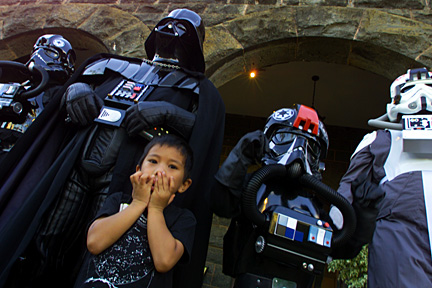
A large crowd gathered with telescopes and binoculars at the Bishop Museum last night to view the collision of a NASA probe with a comet 83 million miles away. The museum hosted its "Comet Collision" Viewing Party for people interested in the first-of-its-kind event. Naked-eye observers were disappointed.
| Bishop Museum "There's thousands of people looking at the sky at nothing," said one onlooker. |
Waikiki Beach More than 10,000 people gathered to see the impact on a giant movie screen. |
Haleakala Scientists measured the curve of light and the comet's trajectory and brightness. |
Hilo More than 200 people cheered when the collision was shown on a large screen. |
NASA Lab "We hit it just exactly where we wanted to," project co- investigator Don Yeomans said. |
IMPACT!
A NASA probe successfully
hits a comet to find clues
to cosmic origins
MORE THAN 2,000 people jammed into Bishop Museum's lawn last night, binoculars in hand and toddlers in tow, expecting to watch a celestial show.
Instead, most saw nothing.
The historic collision of a NASA spacecraft with a comet half the size of Manhattan was not viewable by the naked eye in most parts of the state, and some could hardly make it out with amateur telescopes.
In space, though, the crash ignited a dazzling Independence Day weekend fireworks display and marked the first time a spacecraft has touched the surface of a comet. "We hit it just exactly where we wanted to," project co-investigator Don Yeomans told the Associated Press.
And some said the fact that they were a part of a first-of-its-kind event was enough. "I guess this is a once-in-a-lifetime opportunity," said Lori Isara, who sat with her parents and 5-year-old son on the museum's lawn last night, gazing at the sky between bites of a plate lunch.
Just before 8 last night, an "impactor" the size of a washing machine from the Deep Impact spacecraft collided with Comet Tempel 1 about 83 million miles from Earth.

NASA engineers looked at images of the successful collision of the Deep Impact probe with the Tempel 1 comet yesterday at the NASA Jet Propulsion Laboratory in Pasadena, Calif. The purpose of the mission is to study the comet's primordial core.
What astronomers glean from the impact -- and the ages-old dust that shoots off from the comet afterward -- could provide valuable clues on Earth's history and formation.
The mission's ulterior goal, though, seems more science fiction than science: Astronomers have said they also hope to learn what comets are made of and how they react in a galactic collision -- information that could prove lifesaving in the event an asteroid or meteor ever comes barreling toward Earth.
The cosmic smashup did not significantly alter the comet's orbit around the sun, and NASA said the experiment does not pose any danger to Earth.
An image by the mother ship showed a bright spot in the lower section of the comet where the collision hurled a cloud of debris into space. When the dust settles, scientists hope to peek inside the comet's frozen core -- a composite of ice and rock left over from the early solar system.
Energy equivalent to about five tons of TNT was produced in the crash. Astronomers expect the crater, once they get a good look at it, to be about seven stories deep and as wide as a football field.

An overflow crowd on Waikiki Beach viewed a screen showing an artist's rendering of the Comet Tempel 1 colliding with a probe from the Deep Impact spacecraft last night. About 10,000 spectators jammed the beach area to view a direct NASA feed of the impact and to scan the skies behind the screen in the hope of seeing the actual event.
"I think I should give out chiropractor's cards," joked Jeff Harris to a buddy he was talking to by cell phone. "There's thousands of people looking at the sky at nothing."
At Waikiki Beach more than 10,000 people gathered to see the impact on a giant movie screen. "It's almost like one of those science-fiction movies," said Steve Lin, a Honolulu physician as his 7-year old son, Robi, zipped around his beach blanket.
Similar stargazing events on Maui and the Big Island brought out hundreds, while professional astronomers were watching the event high atop Mauna Kea and Haleakala -- both of which had major roles in the experiment's data gathering.

NASA Mission Manager Keyur Patel, left, and Project Manager Rick Grammier hugged yesterday at the NASA Jet Propulsion Laboratory in Pasadena, Calif., after the collision.
"It's mind-boggling," said 15-year-old Thomas Wilson, a Kalaheo High School student. "We're watching the future unfold."
At a University of Hilo auditorium, more than 200 people cheered, applauded and oohed when the collision was shown on a large screen.
The Deep Impact spacecraft was launched in January with two parts: a larger "fly-by" spacecraft and a smaller "impactor" vehicle comprising mostly copper. The comet was speeding along at 23,000 mph when it was hit.
The impactor was released about 24 hours before impact. It had a camera to relay images of the comet's nucleus before it was wiped out in the crash.
More than 100 professional observatories worldwide were focused on the event last night, as well as orbiting satellites and amateur telescopes.
It will take years, though, to analyze all the data from the collision. The earliest information astronomers could release would likely come in a few weeks.

Kanai Nakanelua Kobayashi, 4, posed with "Star Wars" characters at the Bishop Museum's Cosmic "Comet Collision" Viewing Party yesterday evening.
E-mail to City Desk
[News] [Business] [Features] [Sports] [Editorial] [Do It Electric!]
[Classified Ads] [Search] [Subscribe] [Info] [Letter to Editor]
[Feedback]
